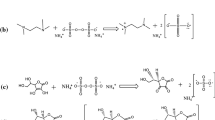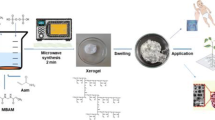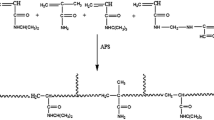Abstract
Hydrogels are polymeric materials used in many pharmaceutical and biomedical applications due to their ability to form 3D hydrophilic polymeric networks, which can absorb large amounts of water. In the present work, polyethylene glycols (PEG) were introduced into the hydrogel liquid phase in order to improve the mechanical properties of hydrogels composed of 2-hydroxyethylacrylate and 2-hydroxyethylmethacrylate (HEA–HEMA) synthesized with different co-monomer compositions and equilibrated in water or in 20 % water–PEG 400 and 600 solutions. The thermoanalytical techniques [differential scanning calorimetry (DSC) and thermogravimetry (TG)] were used to evaluate the amount and properties of free and bound water in HEA–HEMA hydrogels. The internal structure and the mechanical properties of hydrogels were studied using scanning electron microscopy and friability assay. TG “loss-on-drying” experiments were applied to study the water-retention properties of hydrogels, whereas the combination of TG and DSC allowed estimating the total amount of freezable and non-freezing water in hydrogels. The results show that the addition of viscous co-solvent (PEG) to the liquid medium results in significant improvement of the mechanical properties of HEA–HEMA hydrogels and also slightly retards the water loss from the hydrogels. A redistribution of free and bound water in the hydrogels equilibrated in mixed solutions containing 20 vol% of PEGs takes place.







Similar content being viewed by others
References
Peppas NA, Bures P, Leobandung W, Ichikawa H. Hydrogels in pharmaceutical formulations. Eur J Pharm Biopharm. 2000;50:27–46.
Lin CC, Metters AT. Hydrogels in controlled release formulations: network design and mathematical modeling. Adv Drug Deliv Rev. 2006;58(12–13):1379–408.
Kim JK, Kim HJ, Chung JY, Lee JH, Young SB, Kim YH. Natural and synthetic biomaterials for controlled drug delivery. Arch Pharm Res. 2014;1:60–8.
Caló E, Khutoryanskiy VV. Biomedical applications of hydrogels: a review of patents and commercial products. Eur Polymer J. 2014. doi:10.1016/j.eurpolymj.2014.11.024.
Amin S, Rajabnezhad S, Kohli K. Hydrogels as potential drug delivery systems. Sci Res Essay. 2011;11:1175–83.
Hu X, Hao L, Wang H, et al. Hydrogel contact lens for extended delivery of ophthalmic drugs. Int J Polym Sci. 2011;2011:1–9.
Ribeiro A, Veiga F, Santos D, Torres-Labandeira JJ, Concheiro A, Alvarez-Lorenzo C. Bioinspired imprinted PHEMA-hydrogels for ocular delivery of carbonic anhydrase inhibitor drugs. Biomacromolecules. 2011;12(3):701–9.
Cetin D, Kahraman AS, Gümüşderelioğlu M. Novel scaffolds based on poly(2-hydroxyethyl methacrylate) superporous hydrogels for bone tissue engineering. J Biomater Sci Polym Ed. 2011;22:1157–78.
Slaughter B, Khurshid S, Fisher OZ, Khademhosseini A, Peppas NA. Hydrogels in regenerative medicine. Adv Mater. 2009;21:3307–29.
John MS, Andrade JD. Water and hydrogels. J Biomed Mater Res. 1973;7:509–15.
Salmerón-Sánchez M, Monleón Pradas M, Gómez Ribelles JL. Thermal transitions in PHEA hydrogels by thermomechanical analysis: a comparison with DSC data. Eur Polym J. 2004;40(2):329–34.
Wood JM, Attwood D, Collett JH. The influence of gel formulation on the diffusion of salicylic acid in polyHEMA hydrogels. J Pharm Pharmacol. 1982;34(1):1–4.
Wood JM, Attwood D, Collett JM. Characterization of poly(2-hydroxyethylmethacrylate) gels. Drug Dev Ind Pharm. 1983;9(1–2):93–101.
Mackie JS, Meares P. The diffusion of electrolytes in a cation exchange resin membrane. Proc R Soc Lond. 1955;232:498–509.
McBrierty VJ, Martin SJ, Karasz FE. Understanding hydrated polymers: the perspective of NMR. J Mol Liq. 1999;80:179–205.
Sakai Y, Kuroki S, Satoh M. Water properties in the super-salt-resistive gel probed by NMR and DSC. Langmuir. 2008;24(13):6981–7.
Baumgartner S, Lahajnar G, Sepe A, Kristl J. Investigation of the state and dynamics of water in hydrogels of cellulose ethers by 1H NMR spectroscopy. AAPS PharmSciTech. 2002;3(4):E36.
Bouwstra JA, Salomon-de Vries MA, van Miltenburg JC. The thermal behaviour of water in hydrogels. Thermochim Acta. 1995;248:319–27.
Goda T, Watanabe J, Takai M, Ishihara K. Water structure and improved mechanical properties of phospholipid polymer hydrogel with phosphorylcholine centered intermolecular cross-linker. Polymer. 2006;47(4):1390–6.
Tomar N, Tomar M, Gulati N, Nagaich U. pHEMA hydrogels: devices for ocular drug delivery. Int J Health Allied Sci. 2012;4:224–30.
Paterson SM, Shadforth AM, Shaw JA, Brown DH, Chirila TV, Baker MV. Improving the cellular invasion into PHEMA sponges by incorporation of the RGD peptide ligand: the use of copolymerization as a means to functionalize PHEMA sponges. Mater Sci Eng C Mater Biol Appl. 2013;33(8):4917–22.
Dursch TJ, Taylor NO, Liu DE, Wu RY, Prausnitz JM, Radke CJ. Water-soluble drug partitioning and adsorption in HEMA/MAA hydrogels. Biomaterials. 2014;35(2):620–9.
Jovašević JS, Dimitrijević SI, Filipović JM, Tomić SLj, Micić MM. Swelling, mechanical and antimicrobial studies of Ag/P(HEMA/IA)/PVP semi-IPN hybrid hydrogels. Acta Phys Pol A. 2011;2:279–83.
Hong KH, Jeon YS, Kim JH. Preparation and properties of modified PHEMA hydrogels containing thermo-responsive pluronic component. Macromol Res. 2009;1:26–30.
Khutoryanskaya OV, Mayeva ZA, Mun GA, Khutoryanskiy VV. Designing temperature-responsive biocompatible copolymers and hydrogels based on 2-hydroxyethyl(meth)acrylates. Biomacromolecules. 2008;9(12):3353–61.
Henning T. Polyethylene glycols (PEGs) and the pharmaceutical industry. PharmaChem. 2002;6:57–9.
Ostrowska-Czubenko J, Gierszewska-Druzyńska M. Effect of ionic crosslinking on the water state in hydrogel chitosan membranes. Carbohydr Polym. 2009;3:590–8.
Ritger PL, Peppas NA. A simple equation for description of solute release I. Fickian and non-Fickian release from non-swellable devices in the form of slabs, spheres, cylinders or discs. J Control Rel. 1987;5:23–36.
Katime I, Mendizábal E. Swelling properties of new hydrogels based on the dimethyl amino ethyl acrylate methyl chloride quaternary salt with acrylic acid and 2-methylene butane-1,4-dioic acid monomers in aqueous solutions. Mater Sci Appl. 2010;1:162–7.
De Kee D, Liu Q, Hinestroza J. Viscoelastic (non-Fickian) diffusion. Can J Chem Eng. 2005;6:913–29.
George KA, Wentrup-Byrne E, Hill DJT, Whittaker AK. Investigation into the diffusion of water into HEMA-co-MOEP hydrogels. Biomacromolecules. 2004;5(4):1194–9.
Tomić S, Mićić M, Filipović J, Suljovrujić E. Swelling and drug release behavior of poly(2-hydroxyethyl methacrylate/itaconic acid) copolymeric hydrogels obtained by gamma irradiation. Radiat Phys Chem. 2007;5:801–10.
Wang J, Wu W, Lin Z. Kinetics and thermodynamics of the water sorption of 2-hydroxyethyl methacrylate/styrene copolymer hydrogels. J Appl Polym Sci. 2008;109:3018–23.
Acknowledgements
The authors would like to thank Rachel Armitage for help with recording SEM images. G. M. B. Tiguman acknowledges the “Science Without Boarders” student exchange program and the University of San Paulo, Brazil.
Author information
Authors and Affiliations
Corresponding author
Rights and permissions
About this article
Cite this article
Hackl, E.V., Khutoryanskiy, V.V., Tiguman, G.M.B. et al. Evaluation of water properties in HEA–HEMA hydrogels swollen in aqueous-PEG solutions using thermoanalytical techniques. J Therm Anal Calorim 121, 335–345 (2015). https://doi.org/10.1007/s10973-015-4446-y
Received:
Accepted:
Published:
Issue Date:
DOI: https://doi.org/10.1007/s10973-015-4446-y




